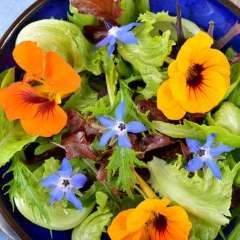Flowers can do more than just bring color to your garden. Many flowers are edible and can bring color and flavor to your dishes. Some flowers also have medicinal properties and can be used to brew teas to soothe cold symptoms or digestive issues.
Here are just some of our favorite edible flowers that you can grow.
Bergamot
Bergamot (monarda), also known as Bee Balm, is a perennial North American wildflower that pollinators love. Both the fresh leaves and blooms are edible and have an “Earl Grey tea” flavor with citrusy undertones. It is great for a salad garnish or infused with butter or ice cream. Keep the blooms coming by

removing spent blossoms from the plant on a regular basis.
Borage
Borage is an annual flower with a cucumber-like flavor. Only the petals are eaten after removing the inner parts of the flower. Borage is excellent in salads and soups. It looks lovely frozen into ice cubes to add that subtle cucumber flavor to summer drinks.
Calendula
Calendula is also known as pot marigold. Only the petals from this annual are eaten. Remove them from the flower heads before using them. Calendula has a tangy flavor that can range from spicy to peppery depending on the variety. Petals can be used fresh in salads, butter, and rice dishes or can be dried to use in soups. Some people call calendula the “poor man’s saffron” because it also provides a yellow color to dishes.
Chamomile
There are two common species of Chamomile, German, and Roman. Both species have edible flowers, but some prefer the sweeter flavor of German chamomile. Chamomile has an earthy, apple-like flavor. Chamomile can be infused into teas, cocktails, and desserts and can be used fresh or dried.
Chives

While chives are often thought of as an herb used mostly for its leaves, both common chives and garlic chives are perennials that produce tasty edible flowers. You should harvest the flowers shortly after they open. They will provide a subtle onion-like flavor to dishes like sauces, salads, and sandwiches.
Echinacea
The leaves, flowers, and roots of the Echinacea or Purple Coneflower plant are all edible. Echinacea is well-known for its medicinal properties and is a popular home remedy for colds. It is easy to grow and is not picky about soil quality, making it a valuable addition to your garden. The petals are edible with a very floral flavor that many improve with the addition of some sweetener to add color to salads and other dishes.
Lavender
Lavender is another perennial herb that is known for its soothing benefits. The flowers have a distinctive flavor reminiscent of rosemary and mint. Lavender can be infused into drinks, ice cream, and other sweet dishes. This flower is potent so a little goes a long way to provide big flavor.
Marigold
Marigolds are a valuable edible flower for your garden. They make a wonderful companion plant especially for cruciferous vegetables as they are known to deter the cabbage moth. The blossoms are edible but do not have much flavor. They are mostly used as garnish to bring bright colors to salads and other dishes.
Nasturtium
Nasturtium is another plant that has edible flowers and leaves. It also makes a wonderful companion plant, especially for cucumbers as it can deter cucumber

beetles. Nasturtium flowers have a peppery flavor that is a wonderful compliment to salads and sauces. The flowers and leaves are also rich in antioxidants.
Pansy
Pansy and other violas, like violets, have edible blossoms. The leaves and roots of pansies are not edible. The blooms have a light floral flavor and are prized for their lovely colors. Blooms can be candied and used for cake decorations or used fresh on salads.
Yarrow
Yarrow has a long history as an important medicinal plant. It has been used to help heal wounds and soothe colds, coughs, and upset stomachs. Both the leaves and flowers are edible and highly nutritious. The leaves have a bitter taste and can be used in salads or cooked like spinach. The flowers have a sweet and spicy flavor and can be used to make tea or added to salads for a splash of color.
Edible flowers are a great addition to your survival garden. They attract beneficial insects and repel pests from your veggies. They also enhance your dishes with exotic flavors and vibrant colors. Some other edible flowers you can grow are squash blossoms, basil flowers, and many more. Just make sure to grow them organically, without any pesticides, and wash them well before eating.
























